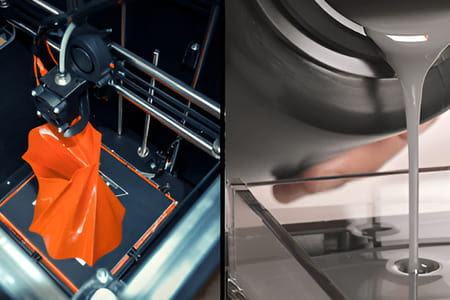
3D printing has revolutionised the way products are manufactured, enabling complex objects to be created with faster production times and a greater level of part customisation. There are several methods for creating objects using this innovative technology. In this post, we explain the differences between the two most common methods: 3D printing using resin vs 3D printing using filament!
Both methods can create fully functional parts with incredible designs, but there are some differences between them.
Both methods can create fully functional parts with incredible designs, but there are some differences between them.
3D printing with filament
Filament printing is the most common 3D printing technique and uses a thermoplastic filament as the main material. The filament of the chosen material is melted and deposited layer by layer to form the designed part. As the thermoplastic is deposited in the melting nozzle, it solidifies, thus generating a functional prototype.
Advantages of 3D printing with filament
- Faster than resin printing
- You can use a wider variety of materials, e.g. PLA, ABS, PETG, Nylon, TPU.
- It is more economical than other manufacturing methods.
- It enables a larger volume of parts to be printed.
3D printing with resin
For resin printing, also called SLA, UV-sensitive resins are used, i.e. a material that solidifies when exposed to an ultraviolet laser. How does it work? The printer consists of a moving platform that lowers into the resin tray and leaves only the thickness of one layer of print. The UV laser then directs the beams to the bottom of the resin tank, drawing the object on the surface of the liquid. Meanwhile, this material hardens when exposed to ultraviolet light. Each time a layer has been completed, we remove the printed prototype from the bottom of the tank to enable the resin to flow again. The process is repeated layer by layer until the complete object has been created.
Advantages of 3D printing with resin
- High precision. It enables parts to be created with a high resolution of detail.
- Creation of very complex parts.
- Smooth and uniform surfaces.
In conclusion, resin printing is mostly used to create highly detailed parts, with very precise finishes, and smooth and uniform surfaces. Filament 3D printing, on the other hand, is more suitable for the creation of objects with greater volume and strength, and for longer series.







